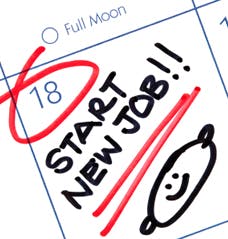Welcome to your new job!
Now, put on these chains and fill out this form …
And then fill out this one … And then fill out this one… And then fill out this one…
Darkness descends … and excitement slowly seeps away…
Empowering new employees from the start
We’re talking old school here. Not quite the workplace dungeons of the Industrial Revolution, but definitely of the pre-Internet realm.
Instead of empowering new employees from before Day One, some companies de-magnetize their enthusiasm with a first day filled with barely legible photocopied paperwork, horribly dry employee handbooks, and outdated training manuals that haven’t been updated since 1999.
All that anticipation and highly engaged first-day energy is completely wiped out by the onboarding electronic magnetic pulse, and then we’re left for dead in a paperwork wilderness.
As I’ve mentioned many times in the past, I’ve played Human Resources on TV, but I have actually done the blocking and tackling associated with sourcing, screening, hiring and onboarding. I know first-hand, at least in smaller companies, that we’ve been quite guilty of a paper-intensive onboarding experience.
The unfortunate reality is that new employees decide their tenure with a company within their first six months on the job. That’s not a lot of time – but it sure adds up to a lot of recruitment and ramping costs.
When the 2014 Candidate Experience Awards were announced earlier this year, it was obvious was that more and more companies have extensive programs in place to improve their overall candidate experience and ensure they provide a positive, rewarding experience as job seekers.
But many of the award winners admitted that they don’t have a very good “internal candidate experience” and many neglect to focus on the bridge between the two when those final candidates transition to new employees.
Essentials for new employees
Of course what doesn’t happen next can and does have a long-lasting effect on their engagement, productivity and tenure. Therefore, it cannot be underscored enough why employers must improve their onboarding processes, where new employees (regardless of classification) are immediately immersed in the company and its culture, rather than hiding them in paperwork shadows on day one.
I’m proud to have finished the Human Capital Institute’s Human Capital Strategist (HCS) and Talent Acquisition Strategist (TAS) certifications this fall, and part of the HCS coursework included the following Onboarding Essentials:
- The time it takes for people to become proficient in their new jobs is critical.
- The “Break Even Point,” according to Michael Watkins, author of The First 90 Days, is a huge productivity factor that is overlooked by many organizations.
- Focus on the first 30-60-90 days to get employees off to a fast start.
- There are different break even points for jobs, depending on complexity and the applicability of the talent supply pool.
- Engagement levels are high when starting a new job, but then can quickly decline.
- Onboarding should be viewed not as an administrative duty but an engagement and developmental experience.
- The research is clear: a careful and planned onboarding program leads to higher engagement and productivity, and reduces turnover.
Administer first, engage second?
Yes, that second to the last one: onboarding should be viewed not as an administrative duty but an engagement and developmental experience.
Unfortunately due to increasing corporate complexity and a constantly changing regulatory environment (not to mention a tightening corporate budget), HR has had little choice but to spend its limited time administering process first, and engaging people second.
To get the engagement, automating as much of the administrative onboarding process as possible is imperative. Otherwise, there’s no way HR (or anyone playing HR on TV) will get to the empowering that we’ve talked about on the TalentCulture #TChat Show.
However, not all of us in the HR software industry feel that way, or at least develop that way, but I know my mothership PeopleFluent does. We certainly know and acknowledge that HR carries the talent torch for us every day. It’s responsible for recruiting, hiring, training and engaging their organization’s most important asset – the people.
What HR needs to empower
That’s why, for HR to empower up, they need to be:
- Better Automated — Streamlining the hiring process with the right technology platform enables HR and new employees to focus on the work at hand and immediately immerse into workplace culture. Allowing your new hires to quickly and painlessly move from their offer letter, through whatever “checks” your organization has in place (background and drug screening for example), to onboarding completely gets them ready to go on day one.
- Empowered (as well) — Empowering HR from day one is the ultimate outcome, which in turn creates a productive and engaging day one for new hires and co-workers alike. The hundreds of hours of administrative labor saved each year when the paper-process is “turned off” empowers HR to be strategic and to create a sustaining, high-performing, competitive organization today. That’s the business partner the executive team wants in their powerhouse.
Rebooting the human interaction in HR is what talent engagement is all about, and what will ultimately drive the business outcomes that make the top-down and the bottom-up alight with smiles.
This was originally published on Kevin Grossman’s Reach West blog.
